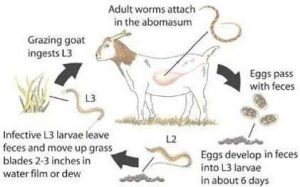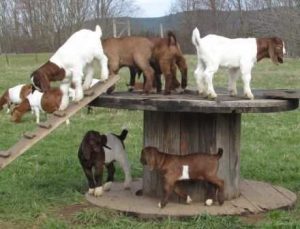Internal parasites are a problem that impact all types of livestock, especially small ruminants such as goats and sheep. Haemonchus Contortus, commonly known as barber’s pole worm or stomach worm is one of the major internal parasites that infect goat and sheep herds. The stomach worm is a prolific reproducer. In its lifespan of 25-50 days it can produce upward of 250,000 eggs. This parasite is transmitted through manure and ingestion. This reproductive rate and method of contamination are what make the stomach worm a herd health issue.

Like many pests, H. contortus thrives in Florida’s subtropical climate. During winter months the larvae hibernate through a process called hypobiosis. This reduction in metabolic activity causes them to be resistant to treatment. They become active again in the spring when the temperatures start to increase, leading to more eggs being excreted just in time for optimal summer conditions. Eggs hatch in the summer months when warm, humid, and rainy conditions persist.
Signs of barber pole worm:

Although animals 6 months and younger tend to be the most susceptible to internal parasites, animals of all ages can be infected with this worm. The stomach worm occupies the animal’s intestines and causes damage by sucking blood. All clinical signs are a result from blood loss, including reduction in overall growth and milk production. Further blood loss results in deficiencies in blood proteins (hypoproteinemia) and anemia.
- Fluid build-up under the animal’s jaw called edema or bottle jaw
- Pale membranes of the eyes and gums
- Panting and lethargy
Lack of treatment will eventually lead to significant blood loss and death. Since H. contortus cannot be seen by the naked eye, it must be detected in manure using a microscope.
Control:
Practicing proper sanitation in your herd and facilities can also help minimize the contamination of parasites. The barber pole worm is spread from animal to animal through oral contact with contaminated manure. Therefore, sanitation of animal facilities is key. Common areas that should be focused on are feed and water troughs. Any other areas where goats feed or congregate should also be cleaned.

Husbandry:
- Flip feed troughs over once animals have finished eating so that they can not defecated in
- Rotate feeding areas during the rainy season since the mud can harbor parasites
- Provide objects for animals to climb on. Make sure that these objects can be easily cleaned.
Dewormers:
Anthelmintic dewormers are the most common method for treating H. contortus. A general deworming schedule every 4 weeks can be utilized since the life cycle of the stomach worm takes less than 3 weeks. This should be done at the beginning of the year during kidding season and throughout the warm season. It is important to treat the whole herd at the same time. A more precise method of deworming can be utilized by examining parasitic egg counts in the manure. If 5-10% of all goats in the herd have more than 500 eggs/gram of manure, then you should treat the whole herd. New animals should always be dewormed and isolated from the rest of the herd for at least a week before introduction. You can prevent worm resistance to dewormers by using the same type of deworm for one year before switching to a different one.
 1
1
